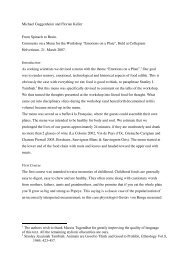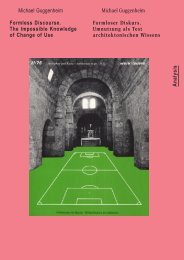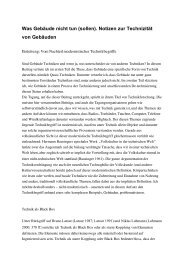The Laws of Foreign Buildings: Flat Roofs and Minarets - Michael ...
The Laws of Foreign Buildings: Flat Roofs and Minarets - Michael ...
The Laws of Foreign Buildings: Flat Roofs and Minarets - Michael ...
You also want an ePaper? Increase the reach of your titles
YUMPU automatically turns print PDFs into web optimized ePapers that Google loves.
Guggenheim 11<br />
‘traditional style’ <strong>of</strong> the Ticino – that is the style that preceded the Stil del Paese – is a<br />
style that requires traditional materials (mostly stone) <strong>and</strong> h<strong>and</strong>iwork, making it badly<br />
suited for a rapidly growing town. Nonetheless, the Stil del Paese is framed as indigenous,<br />
literally meaning the style <strong>of</strong> the countryside, the village, <strong>and</strong> the place at once.<br />
Against this backdrop, the local authorities label the new as a whole as a foreign ‘Nordic<br />
Import’, without any qualification <strong>of</strong> which part is responsible for the qualification<br />
<strong>and</strong> what precisely constitutes the local, but rather using vague terms such as ‘character’<br />
<strong>and</strong> ‘milieu’. <strong>The</strong> distinction between the local <strong>and</strong> the import rests on seemingly obvious<br />
assumptions <strong>of</strong> the wholeness <strong>of</strong> the local <strong>and</strong> the foreign.<br />
<strong>The</strong> promoters <strong>of</strong> modernism try to frame another relation between time <strong>and</strong> place. By<br />
pointing out that the modern style in Germany is thought to come from the south, Keller<br />
breaks the link between the modern <strong>and</strong> place. For him ‘our architecture’ is the architecture<br />
that stems from the present, a specific time rather than a place. Modernism has no<br />
place; it is international. 6 Rather than deriving desired forms from the past <strong>of</strong> the same<br />
location, the moderns derive them from the same period, but other places. <strong>The</strong> period is<br />
one <strong>of</strong> modern man, who connects to nature, wherever he or she is. Ironically, this portrayal<br />
is contrary to the semantic repertoire that links the indigenous with nature <strong>and</strong> the<br />
modern with culture. Keller manages to link two building parts with this opposition<br />
between the placeless modern <strong>and</strong> the traditional local: he portrays the natives as not<br />
interested in their l<strong>and</strong>scape whereas modern man has an urge to connect to the beautiful<br />
l<strong>and</strong>scape by creating big windows. <strong>The</strong> size <strong>of</strong> windows defines modern lifestyle,<br />
because the windows are the technology to connect to nature. <strong>The</strong>y are not examples<br />
<strong>of</strong> a style, but a technology to connect to nature.<br />
<strong>The</strong> second building part, the flat ro<strong>of</strong>, is the issue on which Maraini <strong>and</strong> Keller converge.<br />
A flat ro<strong>of</strong> is materialized, since it is not the flat ro<strong>of</strong> anymore as such that is<br />
linked to a given lifestyle, but the quality <strong>of</strong> its execution. It turns out that flat ro<strong>of</strong>s<br />
become pro<strong>of</strong>s <strong>of</strong> the acceptability <strong>of</strong> modern architecture, not because they are uniquely<br />
linked to modern buildings, but because they are particularly difficult to build.<br />
Maraini <strong>and</strong> Keller both create a distinction between good <strong>and</strong> bad architecture <strong>and</strong> a<br />
shift towards a relational underst<strong>and</strong>ing <strong>of</strong> fit. What is now excluded <strong>and</strong> legally banned<br />
is bad architecture, <strong>and</strong> architecture that disturbs the existing townscape, a notion that<br />
does not relate to a specific building part anymore, but to the quality <strong>of</strong> an architect’s<br />
design or the execution <strong>of</strong> building work. <strong>Flat</strong> ro<strong>of</strong>s for Keller were not preferable<br />
because they were modern, but because they had preferable structural qualities, provided<br />
they were expertly crafted. <strong>The</strong> education <strong>of</strong> the lay people allowed killing two birds<br />
with one stone. First, it allowed attributing the rejection <strong>of</strong> the modern style to a lack<br />
<strong>of</strong> education, rather than a problem <strong>of</strong> the local versus the foreign. Second it allowed<br />
materializing the problem <strong>of</strong> the flat ro<strong>of</strong> as one <strong>of</strong> building quality rather than <strong>of</strong> specific<br />
building parts. What led to the bad image <strong>of</strong> modern architecture was not so much a technology,<br />
but the structural failures <strong>of</strong> modern buildings created by bad builders.<br />
At the end <strong>of</strong> the dispute stood a shift: initially, buildings were understood as stylistic<br />
<strong>and</strong> thus symbolic units related to either time or place (contemporary ¼ modern ¼ international/foreign<br />
vs traditional ¼ local ¼ old). This definition occurred either by very<br />
broad terms or narrowly through the linking <strong>of</strong> building parts such as windows <strong>and</strong> ro<strong>of</strong>s<br />
with these styles. In an intermediate step, windows were technologized as providing<br />
11







